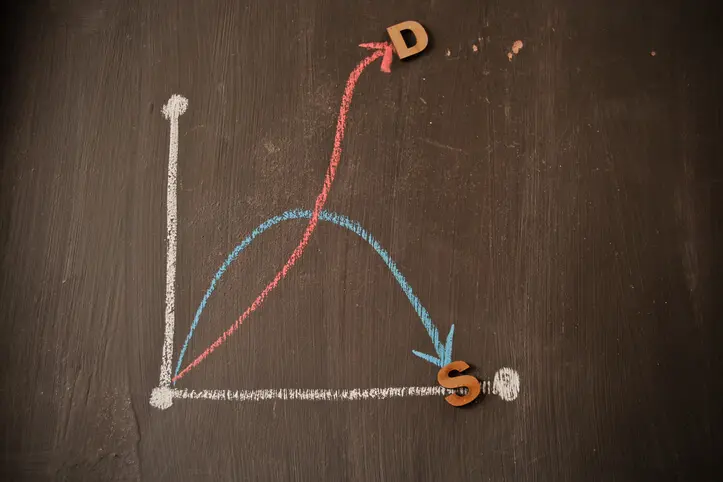Inventory shrinkage occurs when the number of products in stock is fewer than those recorded on the inventory list. This loss of inventory can be attributed to a variety of factors, such as employee theft, shoplifting, damage, administrative or cashier errors, incorrect recording, or vendor fraud. Inventory shrinkage is a key problem for retailers and can have a significant impact on businesses – loss of inventory ultimately means loss of profits. It can also result in decreased productivity and customer satisfaction and can lead to cash flow problems. It is understandably crucial for businesses to understand shrinkage and take proactive steps to minimize its impact.
Definition of Inventory Shrinkage
Inventory shrinkage describes the loss of inventory and can be defined as the difference between the recorded inventory on a company’s balance sheet and its actual inventory levels. Shrinkage can either be normal (planned) or abnormal (due to errors or dishonesty). It occurs across many industries from restaurants and hotels to retailers, manufacturers, and warehouses.
Retail Stores: Although retail industries experience normal shrinkage due to factors such as goods not selling before styles change, abnormal shrinking is far more common. Internal theft, shoplifting, damaged products, and incorrect ordering all negatively impact the inventory shrinkage rate of retail stores.
Warehousing and Distribution Centers: These businesses may experience shrinkage due to theft by employees or external parties, as well as errors in shipping and receiving processes. Items are also often easily damaged as products are moved around large facilities, stacked, and moved again, often using forklifts or other heavy machinery.
Manufacturing Companies: Inventory shrinkage in manufacturing can result from errors in production processes, such as defective or spoiled goods. Theft by employees or suppliers, as well as discrepancies in inventory tracking, can also contribute to shrinkage.
Food and Beverage Industry: Businesses in this sector are particularly susceptible to shrinkage due to perishability. Spoilage, expiration, and damage during storage or transportation contribute to inventory shrinkage. Theft, especially of high-value items like alcohol, can also be a significant factor.
E-commerce and Online Retail: Inventory shrinkage in e-commerce businesses may occur due to similar reasons as traditional retail, including theft, mismanagement of inventory, and errors in fulfillment processes. Additionally, issues such as fraudulent returns or chargebacks can contribute to shrinkage.
Why Inventory Shrinkage is Important
Effectively managing inventory shrinkage is crucial for businesses due to its potential negative repercussions on profitability and the supply chain. A company’s bottom line is directly impacted by inventory shrinkage as inventory that is damaged or goes missing, represents a loss of potential sales and reduced profit margins. In instances where a business is operating on thin margins, the impact can be especially significant. If shrinkage is not effectively managed, profitability can be further eroded due to additional expenses and operational costs that may be incurred: businesses may not only need to invest in security measures, such as surveillance systems or security personnel to deter theft but also conduct regular inventory audits to identify and address shrinkage issues. Stockouts or delays in fulfilling customer orders due to inventory shrinkage can negatively impact customer satisfaction and may even result in lost sales and damage to the company’s reputation. When inventory levels are not accurately tracked or managed, it can lead to discrepancies in forecasting and demand planning. This may cause supply chain disruption as suppliers may struggle to meet production schedules or incur additional costs to expedite orders. High and persistent levels of shrinkage may raise concerns about the company’s internal controls, management practices, and financial health. This can erode trust among stakeholders such as investors, creditors, and business partners, which can have long-term implications for the company’s ability to secure financing, attract investment, and maintain business relationships. In cases where inventory shrinkage is as a result of fraudulent activities or non-compliance with regulations, businesses may face legal and regulatory risks, including fines, lawsuits, and damage to their reputation.
Overall, effectively managing inventory shrinkage is essential for maintaining profitability, operational efficiency, and stakeholder trust. By implementing proactive measures to prevent shrinkage and conducting regular audits to identify and address any issues, businesses can minimize the negative repercussions and optimize their supply chain operations.
How to Calculate Inventory Shrinkage
It is crucial for a business to be able to accurately calculate inventory shrinkage within their organization. In order to do this, you can make use of the following simple formula:
Total Value of Inventory Recorded by Accounting (Book Inventory) - Total Value of Inventory You Actually Have (Actual Inventory) = Inventory Shrinkage Value
Let us take a closer look at the components within this formula and the steps to follow in order to apply it.
Determine Book Inventory: Review your accounting records or inventory management system to find the recorded inventory level. This is the inventory level that should be on hand according to your records.
Determine Actual Inventory: Physically count all the items in your inventory. This can be done through manual counts or by using inventory management software and barcode scanners to track inventory levels accurately.
Calculate the Difference: Subtract the Book Inventory from the Actual Inventory. This will give you the amount of inventory that is unaccounted for or lost.
Let us say, for example, that you conducted a physical count of your inventory and found that you had 900 units on hand. However, according to your accounting records, you should have 1,000 units in stock. We apply the formula: Book Inventory (1,000 units) – Actual Inventory (900 units) = Inventory Shrinkage Value (100 units).
As it is easier to compare percentage values than total values, our next step is to convert the Inventory Shrinkage Value into a percentage. In order to do this, we follow the following formula:
Inventory Shrinkage Value / Total Value of Inventory Recorded by Accounting (Book Inventory) = Inventory Shrinkage Rate x 100 = Inventory Shrinkage Rate Percentage
We therefore divide the Inventory Shrinkage Value (100 units) by the Book Inventory (1,000 units) to get the Inventory Shrinkage Rate (0.1). Now we multiply the Inventory Shrinkage Rate by 100 (0.1 x 100) to get our Inventory Shrinkage Rate Percentage (10%).
So, your Inventory Shrinkage Rate Percentage is 10%. This means that 10% of your inventory is unaccounted for or lost due to various factors.
By following the steps and understanding the significance of each component in the formula, you’ll be equipped to accurately calculate inventory shrinkage within your organization and take proactive steps to address any issues identified.
Types of Shrinkage
As we have determined, inventory shrinkage can occur due to various factors, both internal and external. We are going to take a closer look at some of the different sources of shrinkage that may be encountered by businesses.
Manufacturer
Manufacturers face a number of challenges which may lead to shrinkage. The loss of raw materials, finished goods, components, or equipment due to theft (internal or external), mishandling, or improper storage are all major sources of shrinkage. Production waste, including defective or damaged products that do not meet quality standards during the manufacturing process as well as obsolete or excess inventory that cannot be sold or used in production, also pose a potential problem. Furthermore, inaccurate inventory tracking and management can result in discrepancies between actual inventory levels and recorded inventory levels, leading to shrinkage
Supplier
Suppliers face yet another set of challenges. Shortages or overages in shipment can lead to shrinkage, where shortages may result in lost sales opportunities and overages to excess inventory that cannot be sold. Discrepancies between received inventory and recorded inventory may occur due to errors in receiving shipments, such as miscounting or misidentification of items. Dishonest suppliers may also engage in fraudulent activities such as billing for items not delivered, inflating prices, or substituting lower-quality goods During the transportation process, from manufacturer to supplier, there is always a risk of goods being damaged, leading to shrinkage when these items are then not able to be used or sold.
Retail
One of the major factors that lead to shrinkage in the retail sector is theft and fraudulent activities. This may include shoplifting, where merchandise is stolen from store shelves, fraudulent returns and exchanges, such as returning stolen merchandise or using counterfeit receipts as well as internal theft by employees, including theft of merchandise, cash, or gift cards. Administrative errors such as inventory tracking, pricing, and cash handling can result in shrinkage for retailers. This includes mistakes in data entry, misplaced items, and discrepancies between physical inventory counts and recorded inventory levels.
Hospitality and Catering
Hospitality and catering businesses are often very vulnerable and affected by a very specific set of factors. Food waste is a major source of shrinkage. This may include spoilage or damage of perishable items during storage, handling or service, overproduction, and leftovers that cannot be reused or sold. Shrinkage in the food and beverage inventory can also occur due to inaccurate portion control or overpouring by staff, resulting in higher costs and reduced profitability. Unfortunately, theft and pilferage of food, beverages, or supplies by employees or customers is also a common source of shrinkage in this industry.
Causes of Inventory Shrinkage
A clear understanding of the main causes of inventory shrinkage and their concrete examples will allow organizations to implement proactive measures to mitigate risks, improve inventory management practices, and minimize losses. Let us further explore some of the main causes that we have highlighted.
1. Shoplifting
Shoplifting is one of the most common causes of inventory shrinkage, particularly in the retail sector and refers to the act of stealing merchandise from a retail store without paying for it. This can be executed in many different ways. Customers may conceal items in their bag or clothing while browsing the store and leave without paying for it or swap the price tags of two items, purchasing a higher-value item at a lower price. Often a distraction tactic is used, where a group of individuals create a distraction in one area of the store while another member of the group steals merchandise.
2. Employee Theft
Employee theft occurs when employees steal merchandise, cash, or other assets from their employer. It can involve various methods and may be perpetrated by individual employees or groups. Employees may steal merchandise directly from the stockroom or warehouse for personal use or resale. A common tactic that is employed is where an employee may give merchandise to friends or family members without scanning or ringing up the items at the checkout – this is known as sweethearting. Cash skimming, where an employee pockets cash from customer payments before it is recorded in the register, may also occur.
3. Administrative Errors
Administrative errors result from mistakes in inventory tracking, recording, and data entry. These errors can lead to discrepancies between actual inventory levels and recorded inventory levels, contributing to inventory shrinkage. Data entry errors occur when a staff member enters incorrect quantities or prices of items into the inventory management system. Discrepancies in inventory count can occur due to difficulties in locating items that have been misplaced or stored in the wrong location. Receiving errors, where the receiving department receives the wrong quantity or type of items from suppliers, lead to discrepancies between received inventory and recorded inventory levels.
4. Supplier Fraud
Dishonest practices by suppliers can result in significant financial losses and inventory shrinkage for the purchasing organization. Overbilling occurs when a supplier inflates prices or charges for items that were not included in the order. This results in higher costs for the purchasing organization. More examples of dishonest practices include suppliers delivering fewer items than what was ordered or agreed upon or compromising product quality and integrity by substituting products ordered with lower-quality or counterfeit goods.
5. Unknown Causes
In some cases, inventory shrinkage may occur due to unidentified or unknown factors. Despite efforts to implement inventory controls and monitoring mechanisms, certain losses may remain unexplained. Examples would include discrepancies between actual inventory counts and recorded inventory levels that cannot be attributed to specific causes. Inadequate internal controls and monitoring mechanisms may result in vulnerabilities that are exploited by perpetrators, making it difficult to identify the exact cause of inventory shrinkage. External factors such as natural disasters, supply chain disruptions, or economic downturns may contribute to inventory shrinkage, but the specific cause may not be readily apparent.
Implementing robust security measures, enhancing employee training and supervision, conducting regular audits and inventory counts, and strengthening internal controls and monitoring mechanisms are important steps that can be taken to counteract the above causes.
Impacts of Inventory Shrinkage
Inventory shrinkage has significant financial and operational impacts on companies, including profit loss, increased costs, and potential price increases. It is essential that companies understand these impacts.
Profit Loss
When inventory is lost or stolen without generating revenue, it represents a direct loss to the company’s bottom line as the company’s net income is reduced. Profit loss due to inventory shrinkage can have several operational consequences. Inventory shrinkage reduces the value of assets on the company’s balance sheet, potentially impacting its ability to generate cash flow or secure financing. The company’s ability to invest in growth opportunities, such as expanding operations or launching new products may be limited. Persistent inventory shrinkage can undermine the financial health and stability of the company, eroding investor confidence and potentially leading to liquidity issues or bankruptcy.
Increased Costs
Increased costs associated with inventory shrinkage can impact various aspects of the company’s operations. Lost inventory must be replenished, incurring additional procurement and production costs. Implementing security measures to prevent theft and shrinkage, such as surveillance systems, security personnel, or anti-theft tags, represents an ongoing expense for the company. In addition, inventory shrinkage can disrupt operations, leading to inefficiencies, delays, and additional costs associated with investigating shrinkage incidents, conducting audits, and implementing corrective measures.
Price Increases
As companies seek to offset losses caused by inventory shrinkage, they may need to introduce price increases which can have several operational implications. Higher prices lead to a reduction in competitiveness which may result in reduced sales volume and market share. Customer dissatisfaction may increase, to the benefit of competitors offering lower-priced alternatives. Ultimately price increases driven by inventory shrinkage contribute to inflationary pressures in the economy, affecting consumer purchasing power and overall economic stability.
Mitigation Strategies for Inventory Shrinkage
The impacts of inventory shrinkage are dire. What solutions and strategies can your company implement to reduce this threat?
1. Implement a Double-Check System
Implementing a double-check system holds many benefits for your company. Most importantly it reduces the likelihood of errors and discrepancies in inventory counts and transactions and increases accountability and transparency in inventory management processes. This acts as a deterrent to internal theft and fraudulent activities. A double-check system involves verifying inventory movements and transactions by requiring multiple individuals to independently verify and confirm inventory counts, receipts, and shipments. Two or more employees should be assigned to independently verify inventory counts during stocktaking and reconciliation processes. Verification of inventory receipts and shipments should be required by both receiving and inventory control personnel. Spot checks and random audits will further ensure compliance with the double-check system.
2. Carefully Screen Potential Employees
Thoroughly screening potential employees reduces the risk of hiring individuals predisposed to theft or fraudulent behavior. In this way a culture of honesty and integrity is built within the organization, enhancing employee morale and trust among co-workers. Comprehensive background checks, including criminal background checks and reference verification, should be conducted for all potential hires. Tools such as integrity tests or personality assessments may also be incorporated in this process. Ongoing training and education on company policies, ethical standards, and the consequences of theft and fraud is essential.
3. Automate Inventory Management
Automating inventory management processes using software and technology solutions has significant benefits for your business. It not only Improves the accuracy and timeliness of inventory data, reducing the risk of errors and discrepancies but also streamlines inventory replenishment and ordering processes, minimizing stockouts and overstocking. Trends, patterns, and areas of shrinkage are rapidly identified, allowing for actionable insights. What steps can your company take to experience these benefits? Invest in inventory management with features such as barcode scanning, real-time tracking, and automated replenishment. Implement RFID (Radio Frequency Identification) technology for accurate and efficient inventory tracking and management and integrate inventory management systems with other business systems, such as point-of-sale (POS) systems and accounting software, for seamless data exchange and reconciliation.
4. Monitor Inventory Shrinkage
Regular monitoring and analysis of inventory shrinkage enables proactive identification and mitigation of shrinkage risks before they escalate. It provides insights for implementing targeted prevention measures and addressing underlying issues contributing to shrinkage and helps track the effectiveness of shrinkage reduction strategies and measure improvements over time. Your company can implement this by conducting regular inventory audits and reconciliation to compare actual inventory counts with recorded inventory levels. It is also beneficial to implement shrinkage reporting mechanisms to capture and document shrinkage incidents, including the nature, frequency, and value of losses. Shrinkage data should be regularly analyzed to identify trends, patterns, and root causes of shrinkage, such as specific products, locations, or individuals.
Case Study: Successes and Failures in Inventory Shrinkage
In conclusion, let us take a look at two case studies that illustrate the successes and failures in implementing strategies to manage inventory shrinkage.
Case Study 1: Success Story
Company: XYZ Electronics (Fictitious Name)
Issue: XYZ Electronics, a retail electronics store, was experiencing significant inventory shrinkage due to shoplifting and internal theft by employees. The company’s profitability was being eroded, and customer satisfaction was declining due to inventory shortages and price increases.
XYZ Electronics implemented a comprehensive inventory management strategy to address shrinkage issues. The company installed surveillance cameras, and security tags on high-value items, and increased security personnel to deter theft and shoplifting. Employees received training on theft prevention techniques, ethical conduct, and the importance of inventory accuracy. Supervisors conducted regular checks and audits to ensure compliance. XYZ Electronics also invested in inventory management software with barcode scanning and real-time tracking capabilities to improve accuracy and efficiency in inventory management processes. They implemented regular inventory audits and shrinkage analyses to identify trends, patterns, and root causes of shrinkage. Actionable insights were used to implement targeted prevention measures.
By implementing these strategies, XYZ Electronics successfully reduced inventory shrinkage by 30% within six months. Profitability improved, and customer satisfaction increased due to better inventory availability and pricing stability.
Case Study 2: Failure Story
Company: ABC Fashion (Fictitious Name)
Issue: ABC Fashion, a clothing retailer, struggled with inventory shrinkage caused by shoplifting, employee theft, and administrative errors. Despite implementing basic security measures and conducting periodic inventory counts, shrinkage rates remained high.
ABC Fashion attempted to address shrinkage issues by implementing a number of strategies. They installed surveillance cameras and security tags on select merchandise but did not invest in comprehensive security solutions. Although they conducted periodic inventory counts on a quarterly basis, they did not have a systematic approach to inventory management. Employee training focused on basic customer service skills and product knowledge but lacked specific training on theft prevention and inventory accuracy.
Despite efforts to address shrinkage, ABC Fashion continued to experience high levels of inventory shrinkage, leading to reduced profitability and operational inefficiencies. The lack of comprehensive security measures, systematic inventory management practices, and employee training contributed to the failure of the strategy.
These case studies highlight the importance of implementing comprehensive strategies, including enhanced security measures, employee training, inventory automation, and data analysis, to effectively manage inventory shrinkage. By learning from both successes and failures, organizations can adopt best practices and proactive measures to safeguard their assets and profitability.






